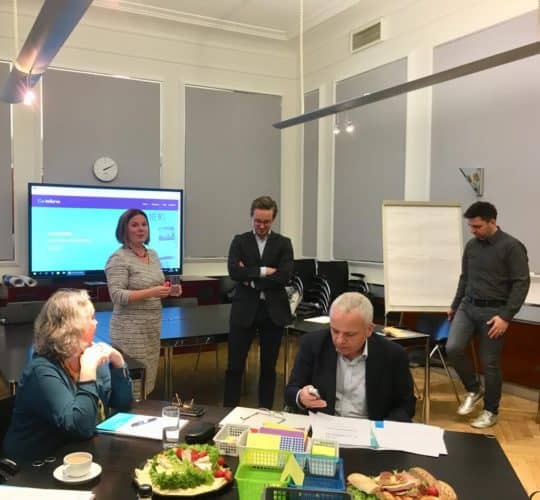Apr 8, 2020 | Brazil, COVID19, Health, Women in Science
By Raquel Guimaraes, postdoc in the IIASA World Population Program
IIASA postdoc Raquel Guimaraes writes about efforts by the scientific community to encourage governments in Latin America and the Caribbean to increase COVID-19 test coverage to reduce vulnerability.

© Kukhunthod | Dreamstime.com
Together with a group of demographers from Latin America and the Caribbean (LAC), and endorsed by more than 250 individuals from the academic community, I contributed to a statement urging governments, the World Health Organization, and the Pan American Health Organization, to take immediate action to drastically increase the coverage of COVID-19 tests in the region. This call for action was disseminated by the British Society for Population Studies, Asociación Latino Americana de Población, Sociedad Mexicana de Demografía, Associação Brasileira de Estudos Populacionais, and the Population Association of America, among other important institutions.
I joined this initiative by invitation from Dr. Enrique Acosta and other colleagues, because I firmly believe that the prospects for the COVID-19 pandemic in the LAC region are rather dramatic. Several studies document that, apart from being globally recognized for its high levels of economic and social inequality, the region also suffers from institutional coordination failures and poor governance, a lack of appropriate resources, and presents a unique epidemiological and demographic profile of its population that escalates the negative prospects of the pandemic. I wanted to explore in more detail why these features of LAC are a source of major concern and require immediate action.
Social and economic inequality in LAC will hamper the enforcement of social distancing and isolation measures, which have proven to mitigate the COVID-19 epidemic in other settings. More than half of the population is in the informal labour market and does not have access to social safety nets. For those covered by the social security system, the benefits already proposed by a few governments of the region such as Brazil, fall short of the daily needs of families. In addition to economic inequality, social inequality, which leads to a high degree of cohabitation between adults and the elderly, increases the exposure of those with the highest risk of complications and death.
In addition, with the closure of schools, children who do not have access to day-care centres and the public- or private education system, often rely on the help of their grandparents, which again brings greater vulnerability to families. Not to mention that these children won’t have ensured their learning opportunities, because their parents are often working and not able to home-school them, thus compromising their education outcomes.
Moreover, LAC is facing a rapid demographic transition and aging process, which is temporarily increasing the prevalence of a young population, meaning that the population age-structure of potential infected individuals differs from that of other settings. However, unlike the more developed countries, LAC’s epidemiologic transition, that is, the transition in which the prevalence of infectious diseases is “substituted” by chronic and degenerative diseases, is not complete. Paradoxically, the region exhibits both the prevalence of diseases that have long been eradicated in more developed contexts (such as malaria, dengue, and tuberculosis) and diseases of richer countries (such as hypertension, diabetes, and neoplasms).
On top of all the above-mentioned vulnerabilities, crisis-management efforts in the region are uncoordinated, and lacking transparency and commitment. Taking Brazil as an example: while some mayors and governors adopt measures of social isolation and prevention against COVID-19, parts of the federal executive power not only disdain the problem, but encourages the population not to meet the requirements established by the Ministry of Health. Such conflicting rules are bound to cause misunderstandings among the LAC population. The COVID-19 pandemic is a crucial moment for institutional coordination to ensure the effective management of the crisis.
As an important and urgent call to action for the pandemic in the region, myself and other LAC researchers are calling for an increase in test coverage and measures of social isolation. As reported in the non-specialized media under the slogan “help to flatten the curve”, social isolation allows the rate of contagion of the virus to be reduced, in order to prevent overloading the capacity of the health system. Existing literature documents that while the virus does not cause major damage to health for the majority of infected persons, it brings a high cost to the health system. Furthermore, the impacts on the later lives of individuals who were hospitalized due to the disease are not yet known. Not to mention, of course, the human tragedy and the costs in terms of lives lost to the disease.
Finally, imperative and immediate action against COVID-19 in LAC will depend on the widespread and low-cost application of tests. This is required because the former rigorous isolation measures mentioned above are highly ineffective if not accompanied by aggressive strategies to detect cases of COVID-19. This highlights the relevance of data collection to better inform policymakers and provide researchers with clear diagnoses of the conditions in the region.
References:
Deaton A (2013). Cap. 3. Escaping death in the Tropics. In The Great Escape: Health, Wealth, and the Origins of Inequality. Princeton University Press.
Hoffman K, & Centeno MA (2003). The Lopsided Continent: Inequality in Latin America. Annual Review of Sociology, 29(1), 363–390. https://doi.org/10.1146/annurev.soc.29.010202.100141
Khemani S, Ferraz C, Finan FS, Johnson S, Louise C, Abrahams SD, Odugbemi AM, Dal Bó E, & Thapa D (2016). Making politics work for development: Harnessing transparency and citizen engagement (Policy Research Report). The World Bank. http://documents.worldbank.org/curated/en/268021467831470443/Making-politics-work-for-development-harnessing-transparency-and-citizen-engagement
Pérez CC, & Hernández AL (2007). Latin–American public financial reporting: Recent and future development. Public Administration and Development, 27(2), 139–157. https://doi.org/10.1002/pad.441
Note: This article gives the views of the author, and not the position of the Nexus blog, nor of the International Institute for Applied Systems Analysis
Nov 12, 2019 | Austria, Communication, Demography, Women in Science
By Nadejda Komendantova, researcher in the IIASA Advanced Systems Analysis Program
Nadejda Komendantova discusses how misinformation propagated by different communication mediums influence attitudes towards migrants in Austria and how the EU Horizon 2020 Co-Inform project is fostering critical thinking skills for a better-informed society.

© Skypixel | Dreamstime.com
Austria has been a country of immigration for decades, with the annual balance of immigration and emigration regularly showing a positive net migration rate. A significant share of the Austrian population are migrants (16%) or people with an immigrant background (23%). The migration crisis of 2015 saw Austria as the fourth largest receiver of asylum seekers in the EU, while in previous years, asylum seekers accounted for 19% of all migrants. Vienna has the highest share of migrants of all regions and cities in Austria, and over 96% of Viennese have contact with migrants in everyday life.
Scientific research shows that it is however not primarily these everyday situations that are influencing attitudes towards migrants, but rather the opinions and perceptions about them that have developed over the years. Perceptions towards migration are frequently based on a subjectively perceived collision of interests, and are socially constructed and influenced by factors such as socialization, awareness, and experience. Perceptions also define what is seen as improper behavior and are influenced by preconceived impressions of migrants. These preconceptions can be a result of information flow or of personal experience. If not addressed, these preconditions can form prejudices in the absence of further information.
The media plays an essential role in the formulation of these opinions and further research is necessary to evaluate the impact of emerging media such as social media and the internet, and their consequent impact on conflicting situations in the limited profit housing sector. Multifamily housing in particular, is getting more and more heterogeneous and the impacts of social media on perceptions of migrants are therefore strongest in this sector, where people with different backgrounds, values, needs, origins and traditions are living together and interacting on a daily basis. Perceptions of foreign characteristics are also frequently determined by general sentiments in the media, where misinformation plays a role. Misinformation has been around for a long time, but nowadays new technologies and social media facilitate its spread, thus increasing the potential for social conflicts.
Early in 2019, the International Institute for Applied Systems Analysis (IIASA) organized a workshop at the premises of the Ministry of Economy and Digitalization of the Austrian Republic as part of the EU Horizon 2020 *Co-Inform project. The focus of the event was to discuss the impact of misinformation on perceptions of migrants in the Austrian multifamily limited profit housing sector.

Nadejda Komendantova addressing stakeholders at the workshop.
We selected this topic for three reasons: First, this sector is a key pillar of the Austrian policy on socioeconomic development and political stability; and secondly, the sector constitutes 24% of the total housing stock and more than 30% of total new construction. In the third place, the sector caters for a high share of migrants. For example, in 2015 the leading Austrian limited profit housing company, Sozialbau, reported that the share of their residents with a migration background (foreign nationals or Austrian citizens born abroad) had reached 38%.
Several stakeholders, including housing sector policymakers, journalists, fact checkers, and citizens participated in the workshop. Among them were representatives from the Austrian Chamber of Labor, Austrian Limited Profit Housing (ALPH) companies “Neues Leben”, “Siedlungsgenossenschaft Neunkirchen”, “Heim”, “Wohnbauvereinigung für Privatangestellte”, the housing service of the municipality of Vienna, as well as the Austrian Association of Cities and Towns.
The workshop employed innovative methods to engage stakeholders in dialogue, including games based on word associations, participatory landscape mapping, as well as wish-lists for policymakers and interactive, online “fake news” games. In addition, the sessions included co-creation activities and the collection of stakeholders’ perceptions about misinformation, everyday practices to deal with misinformation, co-creation activities around challenges connected with misinformation, discussions about the needs to deal with misinformation, and possible solutions.
During discussions with workshop participants, we identified three major challenges connected with the spread of misinformation. These are the time and speed of reaction required; the type of misinformation and whether it affects someone personally or professionally; excitement about the news in terms of the low level of people’s willingness to read, as well as the difficulties around correcting information once it has been published. Many participants believed that they could control the spread of misinformation, especially if it concerns their professional area and spreads within their networking circles or among employees of their own organizations. Several participants suggested making use of statistical or other corrective measures such as artificial intelligence tools or fact checking software.
The major challenge is however to recognize misinformation and its source as quickly as possible. This requirement was perceived by many as a barrier to corrective measures, as participants mentioned that someone often has to be an expert to correct misinformation in many areas. Another challenge is that the more exciting the misinformation issue is, the faster it spreads. Making corrections might also be difficult as people might prefer emotional reach information to fact reach information, or pictures instead of text.
The expectations of policymakers, journalists, fact checkers, and citizens regarding the tools needed to deal with misinformation were different. The expectations of the policymakers were mainly connected with the creation of a reliable, trusted environment through the development and enforcement of regulations, stimulating a culture of critical thinking, and strengthening the capacities of statistical offices, in addition to making relevant statistical information available and understandable to everybody. Journalists and fact checkers’ expectations on the other hand, were mainly concerned with the development and availability of tools for the verification of information. The expectations of citizens were mainly connected with the role of decision makers, who they felt should provide them with credible sources of information on official websites and organize information campaigns among inhabitants about the challenges of misinformation and how to deal with it.
*Co-Inform is an EU Horizon 2020 project that aims to create tools for better-informed societies. The stakeholders will be co-creating these tools by participating in a series of workshops in Greece, Austria, and Sweden over the course of the next two years.
Adapted from a blog post originally published on the Co-Inform website.
Note: This article gives the views of the author, and not the position of the Nexus blog, nor of the International Institute for Applied Systems Analysis.
Jul 31, 2019 | Alumni, IIASA Network, India, Women in Science
By Nandita Saikia, Assistant Professor of Population Studies at Jawaharlal Nehru University, New Delhi, and former postdoctoral researcher at IIASA
IIASA alumna Nandita Saikia, looks back on the two years that she spent living in Austria while working as a postdoctoral researcher in the World Population Program.
The submission of my PhD thesis, marriage, taking up a university position, and becoming a mother, all happened rather quickly for me. By the time I realized that I wanted to experience working outside of my own country, a good five years had flown by from the day that I received my PhD. For a female academic, who is trying to balance family and work, a decision to move abroad was never going to be easy. It needed a lot of planning, not only in terms of the research topic that I wanted to pursue, but also in terms of organizing things in a way that would lead to the least disruption for the research students I was supervising and of course, my family.

Nandiita Saikia | © Nandita Saikia
With little hope and many conditions, I searched for postdoctoral positions on the websites of various institutes. I was amazed when I found an advertisement for a postdoc position at IIASA, which mentioned that it had extended application deadlines for another 18 months – specifically to accommodate female candidates on maternity leave. This gender sensitive rule made my application possible, and ultimately gave me a rich experience and memories that I will cherish forever.
Looking back at the past two years at IIASA, a long list of reasons why this was such an amazing time of my and my family’s lives, comes to mind. The institute is housed in a beautiful two hundred and seventy five year old castle in Laxenburg just outside of Vienna. As an IIASA employee, my family and I could access the green imperial park once meant for Austria’s iconic empress Sissi, at any time. Apart from massive, century old trees that may have shaded Sissi on her own visits, the park contains a spring, a waterfall, and a lake with numerous monuments to Austrian royal families that frequented it over the centuries. The lush green trees, the musical sound of the spring, together with chirping wild ducks and swans, the Laxenburg castles, the tall yellow church under the deep blue sky – all constantly stimulated the spirit of a nature lover like me.
In terms of the more practical aspects of working at IIASA, staff from administration were always available to address all our personal and professional issues efficiently and warmly. We were supported with everything from extending our visas, finding a suitable place to live, and communicating with my son’s school in German, to locating the right physician. The IIASA Communication Department also helped me to convey the meaning of my research in “non-technical language” to a wider audience, for whom the findings are ultimately meant.
The soul of IIASA is truly international and inter-disciplinary. From North to South, East to West, I met colleagues from all parts of the world. The overall research environment is conducive to doing quality research. Our program director, Wolfgang Lutz, extended all possible support for me to stay at IIASA for two years. I however still had enough freedom to manage my responsibilities in terms of the supervision of my PhD students back in India.
IIASA always encourages its employees to be active and fit and supports them to do this in numerous ways. There are a number of clubs and activities on offer, including yoga, a music club, a running club, a swimming club, cycling, German lessons, aerobics, and a tennis club. The institute also maintains a gym for staff members. Some of my colleagues even kept workout clothes in the office for when they could manage to participate in some of these activities amidst their busy schedules. Although it was of course not possible to be in all the clubs, you had a choice, which contributed to the overall “feel good” environment. Being an international research organization, IIASA celebrates the different cultures of its staff members by organizing themed social gatherings like Asia Day, Latin American Day, Canada Day, and Mediterranean Day, to name a few, during which staff have the chance to taste authentic homemade cuisines and see cultural music or dance performances by colleagues. My heart knew no bounds when I got a chance to perform a Bollywood number and an Indian folk dance with my international colleagues!
I also developed an affinity with the IIASA Women in Science Club, which often organized “Meet, Greet and Eat” sessions during which we had the opportunity to interact with established women scientists in an informal way. It was indeed an eye opener to learn about how they overcame common challenges either in their early or later careers.
During our stay, we fully experienced life in Vienna, which has repeatedly been ranked as the best city in the world to live in. The centrality of Vienna also helped us to explore many neighboring countries. In our second year, we lived in Laxenburg where we felt very much at home. We loved how smoothly the little town runs while offering everything needed for a high quality life when raising young children.
Our time at IIASA was extremely productive, but we still felt as if we were in Vienna for a two-year long vacation! If someone asks me whether they should consider IIASA for a post doc or the Young Scientists Summer Program, my answer will be: “Yes, don’t even think twice!”
Nandita Saikia was a postdoctoral researcher at IIASA from 2017 to 2019. More information available at www.nanditasaikia.com.
Note: This article gives the views of the author, and not the position of the Nexus blog, nor of the International Institute for Applied Systems Analysis.
Aug 10, 2018 | Demography, Education, Risk and resilience, Young Scientists

© SasinTipchai | Shutterstock
By Sandra Ortellado, 2018 Science Communication Fellow
Science fiction depicts the future with a combination of fascination and fear. While artificial intelligence (AI) could take us beyond the limits of human error, dystopic scenes of world domination reveal our greatest fear: that humans are no match for machines, especially in the job market. But in the so-called fourth industrial revolution, often known as Industry 4.0, the line between future and fiction is a thread of reality.
Over the next 13 years, impending automation could force as many as 70 million workers in the US to find another way to make money. The role of technology is not only growing but also demanding a completely new way of thinking about the work we do and our impact on society because of it.
Rather than focusing on which jobs will disappear because of technological disruption, we could be identifying the most resilient tasks within jobs, says J. Luke Irwin, 2018 YSSP participant. His research in the IIASA World Population program uses a role- and task-based analysis to investigate professions that will be most resilient to technological disruption, with the hope of guiding workforce development policy and training programs.
“We are getting better and better at programming algorithms for machines to do things that we thought were really only in the realm of humans,” says Irwin. “The amount of disruption that’s going to happen to the work industry in the next ten years is really going to impact everyone.”
However, the fear and instability created by the potential disruption elicit chaos, and the response is hard to organize into constructive action. While the resources remain untapped, creativity and imagination are wasted on speculation instead of preparation.
“I couldn’t stand that there’s all this great evidence-based work out there about how we can improve people’s lives and no one is using it,” said Irwin, “I’m trying to align a lot of research and put it in a place where you can compare it and make it more useful and more transferable between the people who would be talking about this: educators, policymakers, employers, and anybody in the workforce.”
Using a German dataset with vocational training as well as time and task information, Irwin will break down jobs into the specific cognitive and physical skills involved and rank the durability of each skill.
Based on the identified jobs and skills, Irwin will go on to draw connections between labor-force capabilities and education policies. His goal is to scale the findings of the most resilient skills to the German labor system so that policymakers and academic institutions can retrain currently displaced workforces and reimagine the future of human work.
After all, while about half the duties workers currently handle could be automated, Mckinsey Global Institute suggests that less than 5% of occupations could be entirely taken over by computers. The future of predictable, repetitive, and purely quantitative work may be threatened, but automation could also open the door for occupations we can’t even imagine yet.
“I think people are amazing and that they have a lot more potential than we are currently capable of fulfilling,” says Irwin.
The World Economic Forum estimates that 65% of children today will end up in careers that don’t even exist yet. For now, an increasingly self-employed millennial generation works insecure, unprotected jobs. The new gig economy, characterized by temporary contracted positions, offers independence but also instability in the labor market.
Without stable work, people lose a sense of security, and that can be dangerous for a policy system that isn’t built to handle uncertainty.
The last industrial revolution caused two or three generations of people to be thrown into poverty and lose everything they had because it was all tied into their job, recalls Irwin.
“Everything gets bad when things are uncertain,” says Irwin, “And this is a very uncertain time. We need to have a better idea of what’s coming so we can actually make some change.”
Irwin, who earned his Master’s in Public Health in 2014, wants his work to have a preventative focus, trying to find those things that not enough people are talking about, but have the potential to make a huge impact on public well-being.
“Especially in the United States, where I live, we’re so tied up with our jobs—it seems like it’s over half our identity,” says Irwin, “We live to work in America.”
In a place like the US, where a job is not only a source of income, but also an identity and a health factor, Irwin’s research offers hope that technological disruption can foster opportunity instead of chaos.
Note: This article gives the views of the authors, and not the position of the Nexus blog, nor of the International Institute for Applied Systems Analysis.
Jun 4, 2018 | Demography, Postdoc, Poverty & Equity, Women in Science

©Nandita Saikia
By Nandita Saikia, Postdoctoral Research Scholar at IIASA
Being an author of a research article on excess female deaths in India in Lancet Global Health, one of the world’s most prestigious and high impact factor public health journals, today I questioned myself: Did I dream of reaching here when I was a little school going girl in the early nineties in a remote village in North East India?
I am the fourth daughter of five. In a country like India, where the status of women is undoubtedly poorer than men even now, and newspapers are often filled with heinous crimes against women, you may be able to imagine what it meant being a fourth daughter. Out of five sisters, three of us were born because my parents wanted a son. My mother, who barely completed her school education, did not want more than two children irrespective of sex, but was pressurized by the extended family to go for a boy after a third daughter and six years of repeated abortions.
I was told in my childhood that I was the most unwanted child in the family. I was a daughter, terribly underweight until age 11, and had much darker skin than my elder sisters and most people from our area, who have fairer skin than average in India. At my birth, my father, a college dropout farmer, was away in a relative’s house and when he heard about the arrival of another girl, he postponed his return trip.
This is a real story, but just one of those still happening in India. The fact that the girls of India are unwanted was observed from the days of early 20th century when it was written in the 1901 census:
“There is no doubt that, as a rule, she [a girl] receives less attention than would be bestowed upon a son. She is less warmly clad, … She is probably not so well fed as a boy would be, and when ill, her parents are not likely to make the same strenuous efforts to ensure her recovery.”
Regrettably, our current study shows that negligence against “India’s daughter” continues to this day.
Discrimination against the girl child can be divided in two categories: before birth and after birth. Modern techniques now allow sex-selective abortion. Despite strong laws, more than 63 million women are estimated to be ‘missing’ in India and the discrimination occurs at all levels of society.
Our present study deals with gender discrimination after birth. We found that over 200,000 girls under the age of five died in 2005 in India as a result of negligence. We found that excess female mortality was present in more than 90% of districts, but the four largest states of North India (Uttar Pradesh, Bihar, Rajasthan, and Madhya Pradesh) accounted for two thirds of India’s total number.
I have to tell you that I was luckier than most girls. Although I was an unwanted child in our extended family, to my mother, this underweight, dark-skinned, little girl was as cute as the previous ones! She gave her best care to her daughter, and she named her “Rani” meaning “Queen” in Assamese. I am still called by this name in my family and in my village.
When I grew up, I asked her several times about her motive for calling me Rani. She always replied: “You were so ugly, the thinnest one with dark skin, I named you as “Rani” because I wanted everyone to have a positive image before seeing you! Also, it is the name of my favorite teacher in high school and she was also a very thin but bright lady!”
The positive conversations with my mother played a crucial role to my desire to have my own identity, and influenced greatly my positive image of myself and my belief that I could do something worthwhile with my life. Much later, when I started my PhD at International Institute for Population Sciences (IIPS), Mumbai, I was surprised to learn that in Maharashtra, one of the wealthiest states of India, second or third daughters are not even given a name, but instead are called ‘Nakusha’, meaning unwanted.
My parents were passionate about educating their daughters, even with their limited means. My father, who was disappointed at my birth, left no stone unturned for my education! By the time I completed secondary school, our village, as well as neighboring villages, congratulated me during the Bihu celebration (the biggest local gathering) for my good performance in school exams. My parents were proud of me by that time; yet, for some strange reason, they always felt themselves weaker than our neighbors who had sons.
Now, people from our village are proud of me not just because I teach in India’s premier university, or that I take several overseas trips in a year, but because they realize that daughters can equally bring renown to their village; daughters can be married off without a dowry; daughters can equally provide old age care to their parents; daughters too can buy property! Due to this attitude and lower fertility levels, many couples now don’t prefer sons over daughters. In a village of 200 households, there are 33 couples that have either one or two daughters, yet did not keep trying for sons. In my own extended family, no one chooses to have more than two children irrespective of their sex. The situation has changed in my village, but not everywhere.
What is the solution of this deep-rooted social menace? We cannot expect a simple solution. However, my own story convinces me that education can be a game changer, but not necessarily academic degrees. I mean a system by which girls realize their own worth and their capability that they can be economically and socially empowered and can drive their own lives. With the help of education, I made myself from an “unwanted” to a wanted daughter!
The purpose of sharing my story is neither self-promotion nor to gain sympathy, rather to inspire millions of girls, who face numerous challenges in everyday life just because of their gender, and doubt their capability, just like I did in my school days. They can make a difference if they want! Nothing can stop them!







You must be logged in to post a comment.